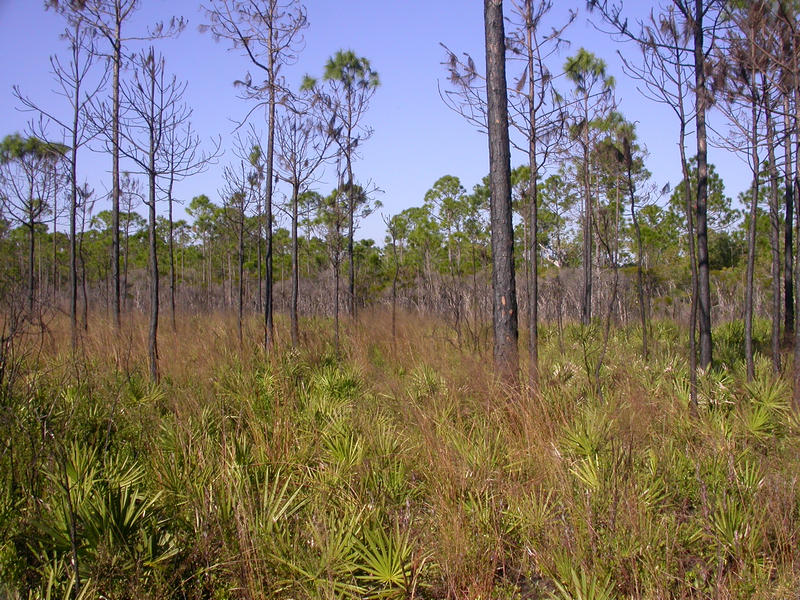Invasive non-native plant species in the Buffer Preserve are a continual management issue and at present are largely confined to the southern boundary of the preserve in residentially developed areas. The following species have been treated as part of the Buffer Preserve's invasive plant management program: camphor tree (Cinnamomum camphora), cogon grass (Imperata cylindrica), Japanese climbing fern (Lygodium japonicum), torpedo grass (Panicum repens), and Chinese tallow (Triadica sebifera). The control program consists of annual herbicidal application, primarily in the fall, as well as mapping and monitoring throughout the year.
Camphor tree is native to eastern Asia and was brought to Florida for cultivation in 1875. It was used for its fragrant oil and timber but ended up not being profitable in Florida plantations. While not listed on any of Florida’s prohibited plant lists, camphor tree is a Category I invasive by the Florida Exotic Pest Plant Council yet is still frequently found as a yard ornamental. The tree grows quickly and produces large amounts of fruit that are very favorable among birds who contribute to dispersal. They prefer dry disturbed areas and can often be spotted popping up on roadsides. Sightings of camphor tree have been limited to the boundary of the preserve, mostly near the St. Joseph Bay County Club Golf Course.
Cogon grass is an aggressive, rhizomatous, perennial grass that is distributed throughout the tropical and subtropical regions of the world. It has become established in the southeastern United States within the last fifty years with Alabama, Mississippi, and Florida having extensive acreage of roadway and pasture infested with cogon grass. It was intentionally introduced from the Philippines into Mississippi as possible forage in 1921. Cogon grass is a threat to natural areas and was first found in the Buffer Preserve in 2005. Only two locations of cogon grass have been documented within the preserve. One has been eradicated, and the other was treated again in 2013. All sites, within and on the boundary of the Buffer Preserve are being treated and monitored. Sites outside the Buffer Preserve are all located on road shoulders where there has been imported fill thus spreading cogon grass throughout the county in the last five years. After Hurricane Michael in October 2018, some road sites treated in the past have become active again. Efforts are underway to work with Gulf County to address these issues.
Japanese climbing fern is a highly invasive plant that forms dense tangled masses over ground cover and shrubs as well as climbing into the tops of trees. These dense mats shade out and eliminate the vegetation below. It was likely introduced as an ornamental in 1932. This invasive non-native species is rapidly spreading in northern and western Florida. Nearby populations found along Department of Transportation right-of-ways pose a significant threat to Buffer Preserve lands. Right-of-way maintenance activities dramatically increase opportunities for the spread of this species especially along the Buffer Preserve's boundary fire lanes and fence lines. The presence and spread of this species pose management challenges for the Buffer Preserve's prescribed fire program. Risk of spot-overs and the spread of wildfires increases when Japanese climbing fern is present.
Originally brought to the U.S. for forage crops, torpedo grass has become one of Florida’s more serious invasives. It is named for its sharp growing tips and can get as tall as three feet in height. While torpedo grass seeds do not germinate well in Florida soils, the spread of this grass is due mostly to rhizome expansion or fragmentation during landscaping. In summer 2019, torpedo grass was observed at several low water crossings on Treasure Road. Low water crossings are found throughout the preserve and are being used to restore natural water flow. Unfortunately, construction materials used to create the crossings contained torpedo grass rhizomes which could lead to clogged waterways. Due to early detection, these sites have been sprayed with wetland-friendly herbicide thanks to the Conservation Corps of the Forgotten and Emerald Coasts.
Chinese tallow is a small to medium sized tree native to China. It was introduced into the United States as an ornamental in the 18th century and has invaded a wide range of natural communities from wetland to upland habitats. Chinese tallow spreads from adjacent developed areas including the St. Joseph Bay County Club Golf Course and neighboring home sites onto the Buffer Preserve. As a result, staff has focused on the eradication of Chinese tallow in areas adjacent to the Buffer Preserve. Significant progress has been made at eradicating tallow on the golf course, which is a large seed source running through the middle of Buffer Preserve lands. Staff has also had many adjacent landowners ask for and receive assistance in removing Chinese tallow from their property adjacent to the Buffer Preserve. Chinese tallow is especially invasive in coastal marshes and removal efforts are aimed at eradicating it from the extensive Money Bayou marshes where it has invaded the outer zones of the marshes near the Treasure Shores development.
These species have the ability to radically disrupt and alter the native biodiversity of the Buffer Preserve's natural communities if not treated and eradicated. It will be critical to continue vigilant treatment of existing species while partnering with Buffer Preserve neighbors and the local community to reduce the potential for new infestations of already established species or invasions by new species by controlling those species on adjacent lands.
Other invasive non-native species are likely to occur in developed areas near Buffer Preserve boundaries. Careful attention needs to be paid to ensure other problematic species which have been documented in Gulf and surrounding counties do not become established.


